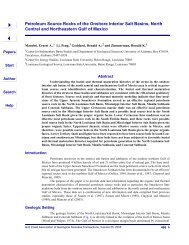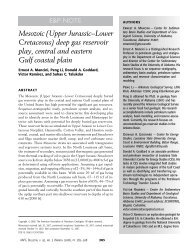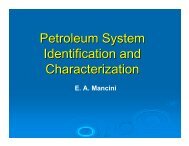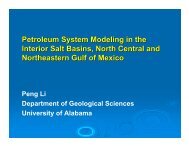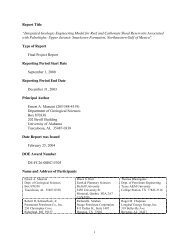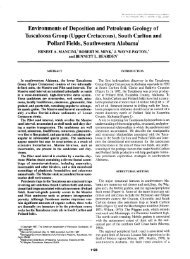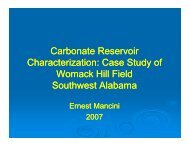Part 4 - Berg - Hughes Center
Part 4 - Berg - Hughes Center
Part 4 - Berg - Hughes Center
You also want an ePaper? Increase the reach of your titles
YUMPU automatically turns print PDFs into web optimized ePapers that Google loves.
Cretaceous reservoirs have shown that the oils produced from the Upper Jurassic, Lower<br />
Cretaceous and many of the Upper Cretaceous reservoirs were generated from organic<br />
matter that accumulated and was preserved in association with the Smackover lime<br />
mudstone beds (Koons et al., 1974; Claypool and Mancini, 1989; Mancini et al., 2001).<br />
The organic rich and laminated Smackover lime mudstone beds are the petroleum<br />
source rocks for most of the oils (Oehler, 1984; Sassen et al., 1987; Claypool and<br />
Mancini, 1989; Mancini et al., 2003). Organic geochemical analyses of the Smackover<br />
source beds and of the oils indicate that the Jurassic oils and many of the Cretaceous oils<br />
originated from the organic matter associated with the Smackover lime mudstone beds.<br />
Smackover samples from the lower and middle lime mudstone beds average 0.81%<br />
total organic carbon according to Claypool and Mancini (1989). Organic carbon contents<br />
of up to 1.54% for the North Louisiana Salt Basin and 9.30% for the Mississippi Interior<br />
Salt Basin have been reported by Sassen et al. (1987) and Sassen and Moore (1988).<br />
Because much of the Smackover has experienced advanced levels of thermal maturity,<br />
the total organic carbon values were higher in the past prior to the generation of crude oil<br />
(Sassen and Moore 1988).<br />
The dominant kerogen types in the Smackover are algal (microbial) and microbial-<br />
derived amorphous (Oehler 1984; Sassen et al. 1987; Claypool and Mancini, 1989). In<br />
updip areas near the paleoshoreline, the Smackover includes herbaceous and woody<br />
kerogen (Wade et al. 1987). The dominant kerogen types in the North Louisiana Salt<br />
Basin are amorphous (microbial) and herbaceous. In the center areas of basins,<br />
Smackover samples exhibit thermal alteration indices of 2 to 4 (Oehler 1984; Sassen<br />
et al. 1987; Claypool and Mancini, 1989). These values represent an equivalent vitrinite<br />
438




